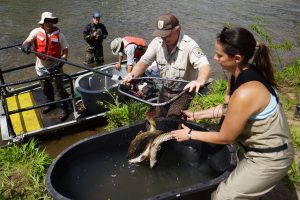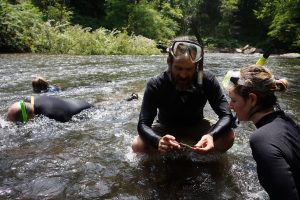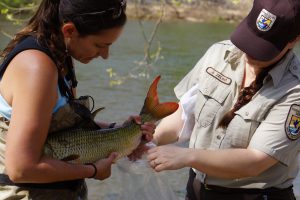2016 Accomplishments – a big year
2017 was a tremendous year for the partnership, from getting snorkeling events going to recording video for upcoming movie shorts about the basin. Read more here.
Little Tennessee Native Fish Conservation Area
A designation of the Little Tennessee Native Fish Conservation Partnership

2017 was a tremendous year for the partnership, from getting snorkeling events going to recording video for upcoming movie shorts about the basin. Read more here.
The partnership just produced it’s first annual accomplishment report. What a great year – from river snorkeling to fish conservation. Check it out.
The U.S. Fish and Wildlife Service concluded the sicklefin redhorse doesn’t need to be placed on the Endangered Species list. Though long recognized by the Cherokee, this fish was discovered by science in the early 1990s. It is found in Swain, Jackson, Macon, Clay, and Cherokee counties, North Carolina, and Towns County, Georgia. For several years, it has been the subject of a focused conservation effort by
 the Service, North Carolina Wildlife Resources Commission, Eastern Band of Cherokee Indians, and Conservation Fisheries, Inc. An agreement signed earlier this year formalized the partnership and brought in the Georgia Department of Natural Resources, Duke Energy, and the Tennessee Valley Authority. Read more. Read more.
the Service, North Carolina Wildlife Resources Commission, Eastern Band of Cherokee Indians, and Conservation Fisheries, Inc. An agreement signed earlier this year formalized the partnership and brought in the Georgia Department of Natural Resources, Duke Energy, and the Tennessee Valley Authority. Read more. Read more.
The Cherokee National Forest has been a leader in offering river snorkeling programs to forest visitors. The Little Tennessee Native Fish Conservation Partnership recently acquired several sets of snorkeling equipment in order to offer more snorkeling outings across the basin. Partnership members recently hit the Oconaluftee River to learn the ins and outs of offering a snorkeling program. Check out the photos.
the ins and outs of offering a snorkeling program. Check out the photos.
The Little Tennessee Native Fish Conservation Partnership semi-annual steering committee is coming up – Friday June 24. Check out the agenda for more details.
Federal, tribal, state, and private organizations came together this April and May to help conserve the sicklefin redhorse. The latest installment of years of effort started by the NC Wildlife Resources Commission, biologists collected data on on sicklefins,  tagged them, and collected sperm and eggs for captive rearing. For more photos, visit: https://www.flickr.com/photos/usfwssoutheast/albums/72157667442533872
tagged them, and collected sperm and eggs for captive rearing. For more photos, visit: https://www.flickr.com/photos/usfwssoutheast/albums/72157667442533872
Little Tennessee River basin partners American Rivers, U.S. Forest Service, and U.S. Fish and Wildlife Service come together to remove a dam on Tennessee’s Citico Creek, improving paddler safety and clearing the way for fish and other aquatic animals to move up- and downstream. Learn more at the American Rivers blog.
Jim Herring, aquatic biologist on the Cherokee National Forest, shared some information on the buffalo run that should be helpful to folks looking to venture to Citico Creek and bear witness to this fish phenomenon. Here’s a summary of Jim’s data on the timing and scale of past events, which can hopefully help you time your visit to this year’s event.
Each April Buffalo fish make a massive spawning run up East Tennessee’s Citico Creek, creating one of the most impressive animal spectacles in the Southern Appalachians. Check out this video of the event from Conservation Fisheries, Inc., and contact Jim Herrig at the Cherokee National Forest (423/476-9751) for information on how you can go watch the run.
Power companies, the Eastern Band of Cherokee Indians, and state and federal agencies have come together to conserve the sicklefin redhorse, a fish found in only six Appalachian counties worldwide and being considered for the federal endangered species list.
Read more about it over at the Fish and Wildlife Service website